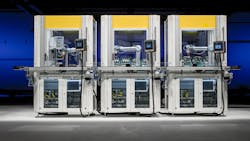When considering the building blocks of your plant, imagine actual building blocks. “The principle of modularity is best explained by Lego building blocks,” said Jakob Dück, global industry segment manager for Harting, in a recent company article. “Innumerable objects can be created from a few basic bricks and defined connecting elements.”
Imagining building blocks has also been applied to individual products and systems to create variability. As an example, Dück explained the platform strategy for the automotive industry in which chassis are used as scalable models along with engines, transmissions and driving axels. Likewise, in industrial control and drive technologies, PLCs, IPCs, HMIs and drive components can be customized from “slices” (or remote I/O blocks) to satisfy the machine that requires automation.
Standardization
While modularization can be complex for some facilities, it has also proven successful technologically and economically. The fact that industrial parts are produced by the thousands (and sometimes millions) inadvertently creates standardization. According to a study conducted by VDMA (2014), while the number of identical components and parts increases, modularization is applied across the value chain, and standard packages are developed with individually priced variants.1
Dück wrote that four market demands and requirements can lead the manufacturing industry to this standardization:
Variability. The higher degree of variability in production systems allows for the manufacturing of a wider range of products. This means systems need to be scalable and to offer expansion options for capacity and output.
Competition. OEMs are forced to expand their business models due to the competition in better life cycle costs (LCC), maintenance, servicing and predictive maintenance. As pay-per-use and other subscription-based options become more popular, OEMs face even steeper competition.
Cost efficiency. It is economically beneficial to expand existing equipment as opposed to replacing the entire system.
Compatibility expectation. There is an assumption within the mechanical engineering sector that modules and subsystems from different manufacturers can be combined for use in a single production line.
Mapping a Modulated System
Dück explained that OEMs should know the following before considering modularization:
- The total estimated input and expenditure for a new, consistently modular product group or family
- The assessment of technical challenges for the planned division of the machine or plant into individual modules
- All operational functions involved in the future service delivery process—development and design, project planning and sales, production and assembly, documentation, service and after-sales services, supply chain and marketing communication
“The real genius of Lego bricks does not reside in the bricks themselves, but in their interconnections,” wrote Dück. “These determine the possible granularity of the division, but also represent the limiting factor for the connection of building blocks.”
Modularization enables OEMs to produce machines that have lower cost and time expenditures. The modular design principle increases the capability of customization, and users can receive a cost- and demand-optimized machine. In today’s industrial market, it no longer suffices to develop good products, sell them to operators and then wait for service and maintenance orders. OEMs now have to keep up with demand and competition by thinking of new and cost-effective ways to produce a machine that can exceed automation expectations.
Reference
- McKinsey & Company, VDMA. (2014). "The future of German mechanical engineering," 59.
About the Author

Marie Darty
Group Multimedia Director, Engineering & Manufacturing
Marie Darty is a digital media professional currently serving as the group multimedia director for the Manufacturing & Engineering Group at Endeavor Business Media. A graduate of Jacksonville State University, she earned her Bachelor of Arts in digital communication with a concentration in digital journalism in December 2016. In her current role, she leads the strategy and production of multimedia content, overseeing video series planning and editing. Additionally, she oversees podcast production and marketing of multimedia content.

